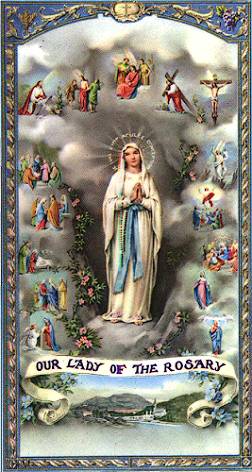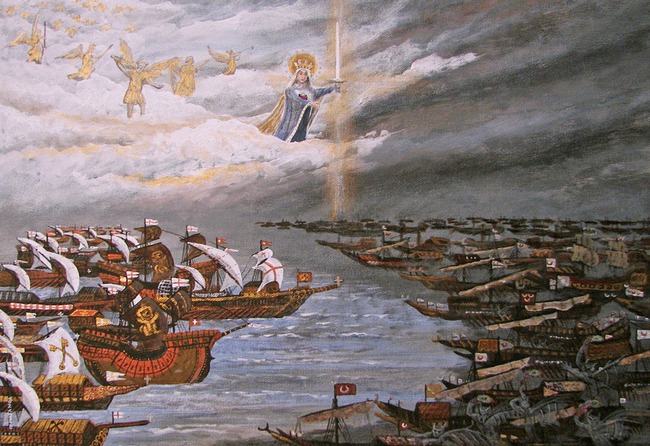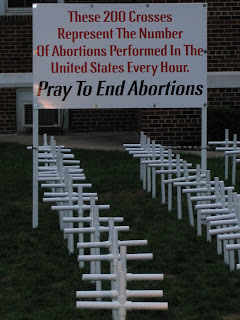Today the Catholic Church celebrates the yearly feast of Our Lady of the Rosary. Known for several centuries by the alternate title of “Our Lady of Victory,” the feast day takes place in honor of a 16th century naval victory which secured Europe against Turkish invasion. Pope St. Pius V attributed the victory to the intercession of the Blessed Virgin Mary, who was invoked on the day of the battle through a campaign to pray the Rosary throughout Europe.
The feast always occurs one week after the similar Byzantine celebration of the Protection of the Mother of God, which most Eastern Orthodox Christians and Eastern Catholics celebrate on October 1 in memory of a 10th-century military victory which protected Constantinople against invasion after a reported Marian apparition.
Pope Leo XIII was particularly devoted to Our Lady of the Rosary, producing 11 encyclicals on the subject of this feast and its importance in the course of his long pontificate.
In the first of them, 1883's “Supremi Apostolatus Officio,” he echoed the words of the oldest known Marian prayer (known in the Latin tradition as the “Sub Tuum Praesidium”), when he wrote, “It has always been the habit of Catholics in danger and in troublous times to fly for refuge to Mary.”
“This devotion, so great and so confident, to the august Queen of Heaven,” Pope Leo continued, “has never shone forth with such brilliancy as when the militant Church of God has seemed to be endangered by the violence of heresy … or by an intolerable moral corruption, or by the attacks of powerful enemies.” Foremost among such “attacks” was the battle of Lepanto, a perilous and decisive moment in European and world history.
Troops of the Turkish Ottoman Empire had invaded and occupied the Byzantine empire by 1453, bringing a large portion of the increasingly divided Christian world under a version of Islamic law. For the next hundred years, the Turks expanded their empire westward on land, and asserted their naval power in the Mediterranean. In 1565 they attacked Malta, envisioning an eventual invasion of Rome. Though repelled at Malta, the Turks captured Cyprus in the fall of 1570.
The next year, three Catholic powers on the continent – Genoa, Spain, and the Papal States - formed an alliance called the Holy League, to defend their Christian civilization against Turkish invasion. Its fleets sailed to confront the Turks near the west coast of Greece on October 7, 1571.
Crew members on more than 200 ships prayed the Rosary in preparation for the battle - as did Christians throughout Europe, encouraged by the Pope to gather in their churches to invoke the Virgin Mary against the daunting Turkish forces.
Some accounts say that Pope Pius V was granted a miraculous vision of the Holy League's stunning victory. Without a doubt, the Pope understood the significance of the day's events, when he was eventually informed that all but 13 of the nearly 300 Turkish ships had been captured or sunk. He was moved to institute the feast now celebrated universally as Our Lady of the Rosary.
“Turkish victory at Lepanto would have been a catastrophe of the first magnitude for Christendom,” wrote military historian John F. Guilmartin, Jr., “and Europe would have followed a historical trajectory strikingly different from that which obtained.”
The Twenty Mysteries
Here is a brief listing and description of all twenty Mysteries.
The Joyful Mysteries
- The Annunciation: The Archangel Gabriel "announces" to Mary that she shall conceive the Son of God.
- The Visitation: Mary visits her cousin Elizabeth, who is pregnant with John the Baptist.
- The Nativity: Jesus is born.
- The Presentation: Mary and Joseph "present" Jesus in the Temple where they meet Simeon.
- The Finding in the Temple: After losing Him, Mary and Joseph find young Jesus teaching the Rabbis in the Temple.
The Luminous Mysteries (The Mysteries of Light)
- The Baptism in the Jordan: The voice of the Father declares Jesus the beloved Son.
- The Wedding at Cana: Christ changes water into wine, his first public miracle.
- The Proclamation of the Kingdom: Jesus calls to conversion (cf. Mk 1:15) and forgives the sins of all who draw near to him.
- The Transfiguration: The glory of the Godhead shines forth from the face of Christ.
- The Institution of the Eucharist: Jesus offers the first Mass at the Last Supper with his apostles, establishing the sacramental foundation for all Christian living.
The Sorrowful Mysteries
- The Agony in the Garden: Jesus sweats water and blood while praying the night before his passion.
- The Scourging at the Pillar: Pilate has Jesus whipped.
- The Crowning with Thorns: Roman soldiers crown Jesus' head with thorns.
- The Carrying of the Cross: Jesus meets His mother and falls three times on the way up Calvary.
- The Crucifixion: Jesus is nailed to the cross and dies before His mother and His apostle John.
The Glorious Mysteries
- The Resurrection: Jesus rises from the dead.
- The Ascension: Jesus leaves the Apostles and bodily "ascends" to heaven.
- The Descent of the Holy Spirit: The Apostles receive the Holy Spirit in tongues of fire in the upper room with Mary.
- The Assumption: Mary is taken bodily--assumed--into heaven by God at the end of her life here on earth.
- The Coronation: Mary is crowned Queen of Heaven and Earth.
Mysteries for Certain Weekdays
Traditionally, many people say the Joyful Mysteries on Monday, the Sorrowful Mysteries on Tuesday, the Glorious Mysteries on Wednesday, and start again with the Joyful Mysteries on Thursday, the Sorrowful Mysteries on Friday. The Glorious Mysteries are then prayed on Saturday and Sunday. Now that the Luminous Mysteries have recently been added, the schedule is:
Monday - Joyful
Tuesday - Sorrowful
Wednesday - Glorious
Thursday - Luminous
Friday - Sorrowful
Saturday - Joyful
Sunday - Glorious
Try to place yourself "into" the scene of the particular mystery as you pray, imagining the sights, smells, sounds, and emotions that Jesus, Mary, Joseph, and other participants experienced during the actual events. It is also okay to meditate on the meaning of the words of the prayers as you pray them, or even to meditate on the person for whom you are offering the Rosary.
















